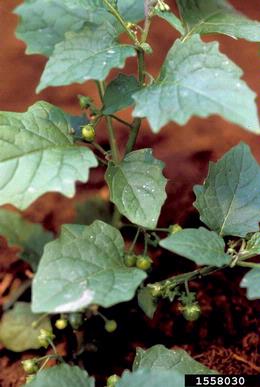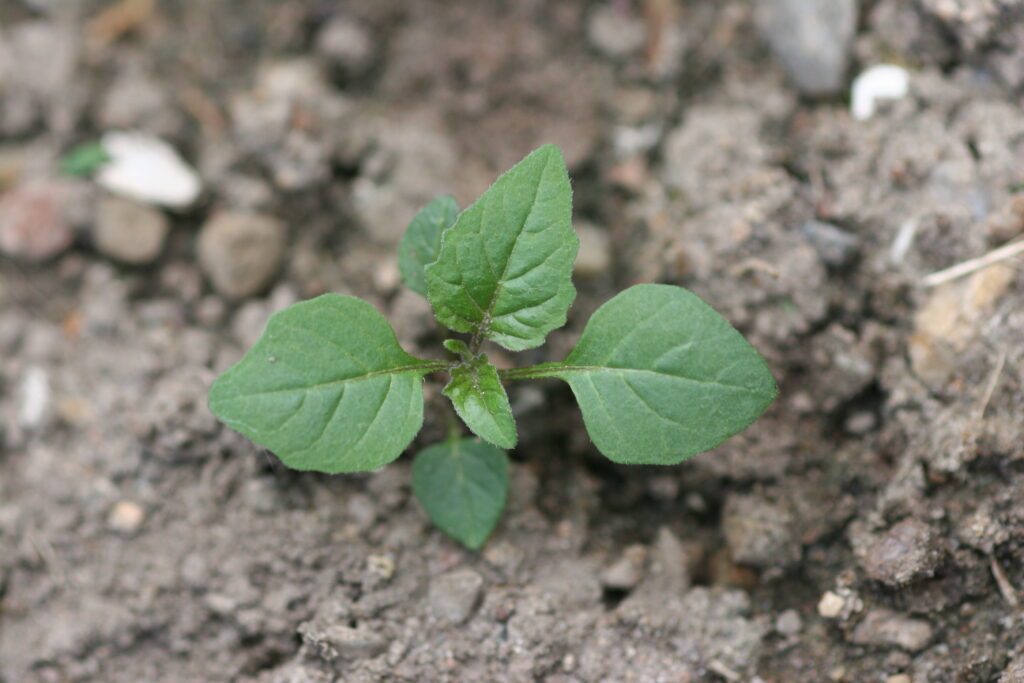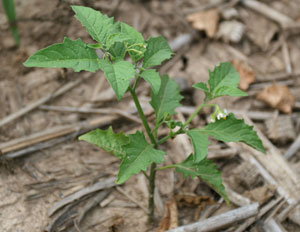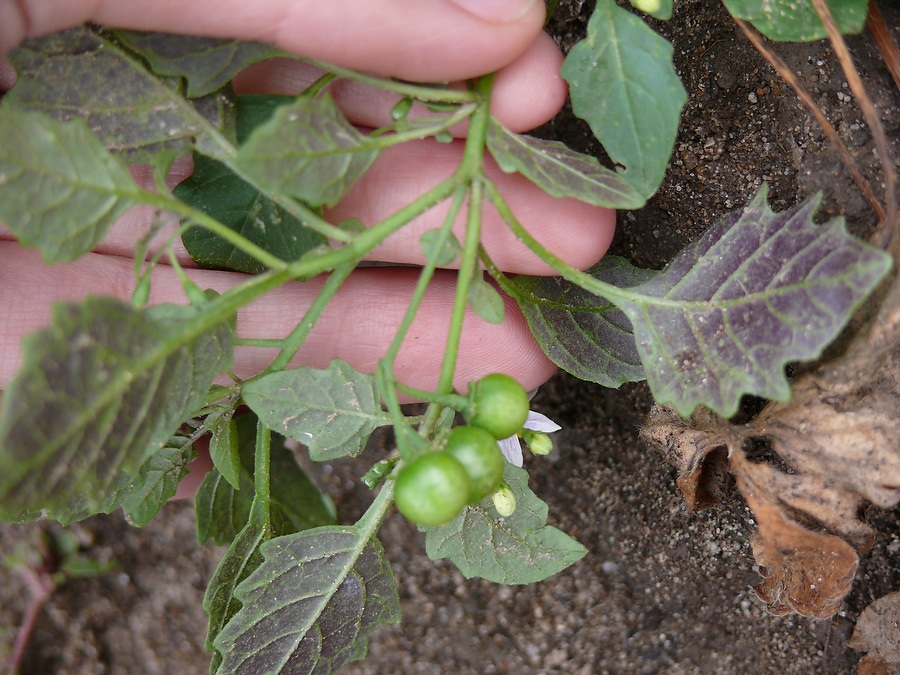Main Content

Written by Joanna Guldin, Rowan College of South Jersey, Gloucester County Intern Scholarship Program
Eastern Black Nightshade (Solanum ptycanthum) is a summer annual broadleaf plant native to the Americas. This fruit-bearing weed can be easily identified at maturity by its bright green foliage and deep purple berries.
Importance as an Agricultural Weed
In agricultural fields, eastern black nightshade competes with crops, interferes with harvest, and lowers crop quality. For example, the immature, green berries of this weed are similar in size to soybeans, making it difficult for the combine harvester to separate the berries from the soybeans. When the berries ripen, they can burst and stick to soybeans during harvest which discolors the beans and attracts dust and soil – this may result in dockage.
Managing these weeds can be difficult because the germination period begins in spring and continues throughout the growing season. As a member of the Solanaceous family, these weeds can harbor diseases, insects, and nematodes that negatively affect potato, tomato, and pepper.
Vegetative tissue and fruit of this weed can be poisonous to all types of livestock as well as humans. The presence of this weed is a concern in pick-your-own operations because children may be attracted to the berries and eat them. Ingestion of this berry can affect the central nervous system and gastrointestinal tract.
Key Characteristics for Identification
| Characteristics | Description |
| Overall Appearance | Stems are erect and branching, up to 3-foot-tall Leaves are 1-3 inches long by 0.4-2.25 inches wide Stems and stalks are purplish Leaves have wavy edges and purple-tinged undersides Plants produce berries that ripen from green to purple |
| Leaf Attributes | Small, egg-shaped cotyledons with a pointed tip First leaves are smooth, egg-shaped with wavy margins Later leaves are slightly hairy, egg- to diamond- shaped Irregularly toothed margins |
| Presence of Hairs | Stem of seedling is hairy Stems are hairless to lightly hairy at maturity Leaves are nearly hairless |
| Flowers | Flowers are white or tinged with purple Five petals are fused at the base creating a star shape Five bright yellow anthers Downward facing clusters, each containing 4 to 7 flowers Blooms between June and September |
Chemical Control Options
For herbicide recommendations, refer to the following publications. Additional commercial crop production guides can be found here. Contact your local county Extension office with specific questions.
- Field Crops: Mid-Atlantic Field Crop Weed Management Guide
- Vegetable Crops: Mid-Atlantic Commercial Vegetable Production Recommendations
- Turfgrass: NJAES Factsheet 385 Broadleaf Weed Control in Cool Season Turfgrasses
- Home Landscape: NJAES Bulletin 272 Weed Management in Ornamental Plantings
Important Note: ALS-inhibitors (group 2) are commonly used to control weeds like eastern black nightshade across a range of cropping systems. Diligence is needed to prevent development of herbicide resistant biotypes on your farm as eastern black nightshade populations resistant to ALS-inhibitor herbicides have been confirmed in Illinois, North Dakota, and Wisconsin. When utilizing ALS-inhibitor herbicides, use the full label rate and tank-mix with another effective herbicide mode of action.
Integrated Weed Management Strategies
Prevent eastern black nightshade infestation by implementing normal tillage and cultivation practices. Tillage is an effective strategy to bury weed seeds deep enough to reduce emergence. However, eastern black nightshade seeds can survive up to 39 years when buried and undisturbed. Research has shown that annual tillage can reduce the number of eastern black nightshade seeds in the soil by 37% every year, as tillage stimulates germination but is also effective at terminating emerged weeds.
Where possible, prepare fields 2-3 weeks in advance to allow the first flush of eastern black nightshade to germinate and emerge before planting the crop. Flame weeding or herbicide can be applied immediately pre-plant to terminate emerged weeds. Planting operations that minimize soil disturbance will reduce the amount of eastern black nightshade emergence as the season goes on, as new seeds will not be brought to the surface. For later planted crops, repeat very shallow tillage every 2-3 weeks to continually stimulate germination. Each tillage event will terminate emerged weeds and reduce eastern black nightshade (and other summer annual weeds) in the soil seedbank – this practice is known as a tilled fallow.
Avoid applying excessive nitrogen to your fields. Eastern black nightshade absorbs nitrogen in excess, so nitrogen will favor these weeds relative to most crops. Use high seeding rates and narrow row spacing for crops to get dense stands that will suppress the weeds. Also, avoid overgrazing on pastures. Intensive rotational grazing is effective in destroying successive flushes of seedlings. Implement sound grazing practices to reduce infestations.
Eastern black nightshade is troublesome because it can germinate seed all summer long wherever moisture is adequate. Protect uninfested areas from contamination by cleaning seeds and berries from tillage implements and harvest equipment. Also avoid spreading contaminated manure onto uninfested fields.
Implementing cover crops into your agricultural field is a good management practice that can suppress weed growth. Cover crops compete with weeds during periods when cash crops are not grown, and they suppress weed seed production. Species that grow from tiny seeds, like eastern black nightshades, tend to stagnate in the shade of cover crops. Early planting of cover crops can promote early closure of the crop canopy and prevent emergence of this weed.



References
Anonymous. Eastern black nightshade – Solanum ptycanthum. Michigan State University. https://www.canr.msu.edu/resources/eastern-black-nightshade-solanum-ptycanthum
Bamka, W., Barbour, B., Williams, C., & Gladney, L. (2013, May). Poisonous Weeds in Horse Pastures. New Jersey Agricultural Experiment Station. https://njaes.rutgers.edu/fs938/
Heap, I. The International Herbicide-Resistant Weed Database. Online. Wednesday, March 30, 2022. Available www.weedscience.org
Lingenfelter, D., Curran, W.S., Werner, E.L. (2021, September 22). Management of Eastern Black Nightshade in Agronomic Crops. PennState Extension.
Mohler, C.L., Teasdale, J.R., & DiTommaso, A. (2021). Major agricultural weeds of the United States and Canada. In L. Barba (Ed.), Manage weeds on your farm: A guide to ecological strategies (pp. 323-328). Sustainable Agriculture Research and Education.